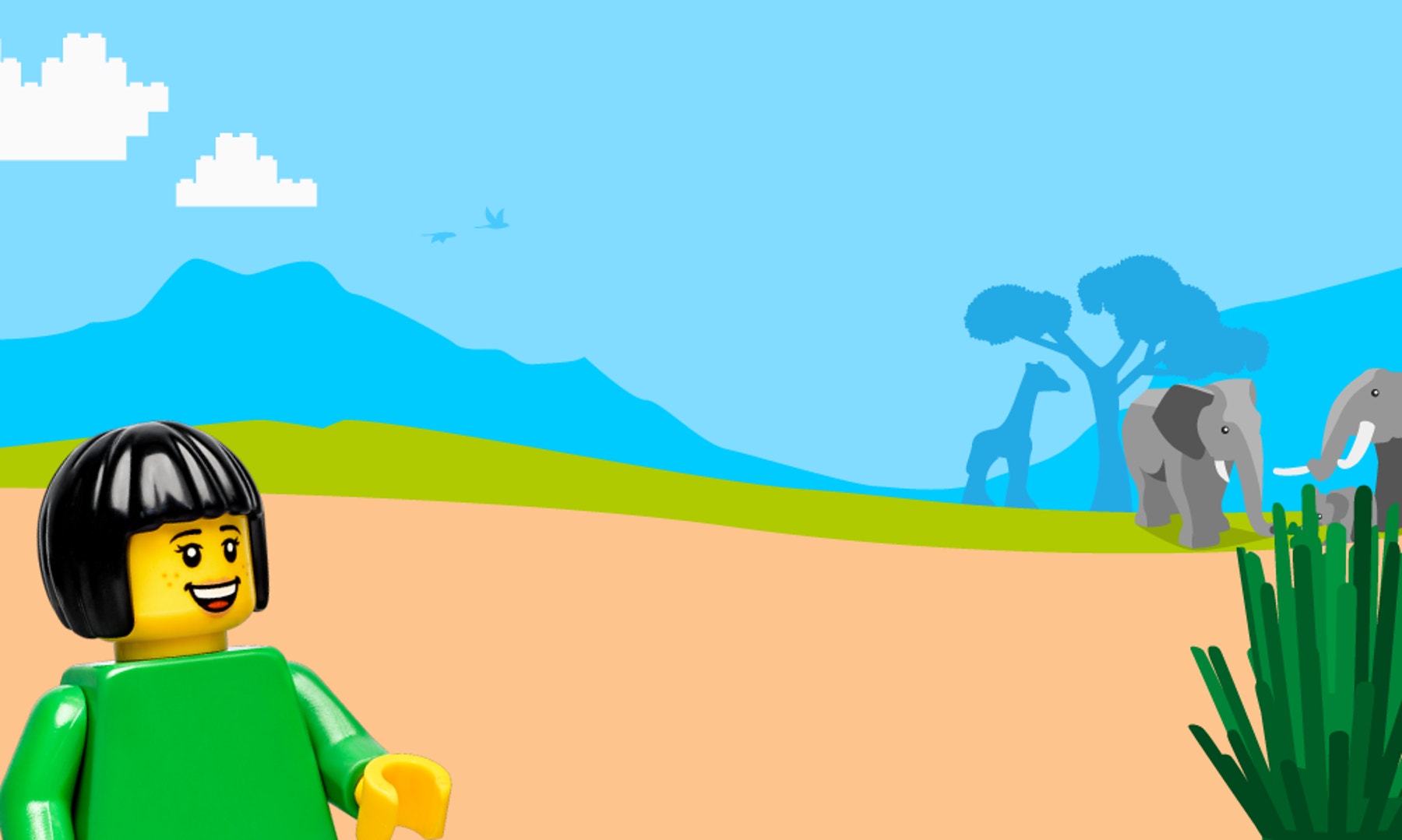Habitats
Sofie learned about the places giraffes live. She wonders about the other animals that live there. What about other places? Can you help her learn?

Prepare
(NOTE: This lesson contains a Part A and a Part B. Both are important to access the full learning of the curriculum. If time is limited, review both parts to choose elements that meet your pupils’ needs.)
In this lesson, the key learning is through observing the diversity of life in different habitats. Designing and building a model is a fun, hands-on way to show learning about that diversity in one habitat and observe classmates’ habitats to compare diversity in different habitats. Encourage pupils to build their ideas for a chosen habitat and the plants and animals that live in it. Reinforce that there is no single correct model.
Consider assigning one habitat to several groups (pairs). Each pair builds an animal from their assigned habitat, and each habitat group collaborates to combine their animals into a single habitat model. Finally, bring everyone together to compare all the plants and animals in the different habitats as a class. As needed, assign habitats to ensure diversity that supports comparison.
- Science Background - Habitats:
- A habitat is the natural home for a plant or animal. Every kind of habitat supports a variety of types of plants and animals.
- For animals, a habitat provides the food, water, climate conditions (temperature, moisture) and shelter that kind of animal needs to survive.
- For plants, a habitat provides the type of light and soil and climate conditions (temperature, moisture) that kind of plant needs.
- Some common land habitats include savannah, forest, desert, mountain, grassland. Water habitats include oceans, rivers, streams, lakes, ponds and swamps/wetlands.
- For young pupils, you may wish to start with very simple and familiar “habitats” like playgrounds, parks or gardens, which pupils can personally observe.
- Build Prior Knowledge - Habitats: Using your core science materials, share information, images and definitions to build prior knowledge.
- Review what pupils know about different habitats on Earth and the types of plants and animals that live in each one, including those near your school community. Pupils will learn more about the topic through this activity.
- Consider common plants and animals in habitats that the class has studied or that are near your school community, including simple ones like parks, ponds or gardens.
- Key vocabulary: habitat, diversity
- Building and Programming Experience: Consider the suggestions in the Unit Plan. For this lesson, you may also want to
- Reinforce with the Colour Sensor tutorial in the SPIKE App Start Menu
- Use the Event, Sensor (Colour) and Sound Blocks sections of the Help>Icon Blocks menu in the SPIKE app to provide more support.
- Materials Locate age-appropriate books, materials or online resources of different habitats. (search term: habitats + location e.g. your local area or another country). Use sites from government agencies, science organisations and educational institutions. Determine how you will share resources with pupils.
- To use the Extension activity, locate and provide learning materials about endangered animals or plants in the habitats represented in the class.
PART A (45 Minutes)
Engage
(Whole Class, 10 minutes)

Introduce the story’s main character(s) and the first challenge: Sofie learned about the places giraffes live. She wonders about the other animals that live there. What about other places? Can you help her learn?
THINK – Facilitate a brief discussion about the lesson topic(s) using the story picture if you wish.
- What is a habitat? (the natural home or environment of an animal, plant or other organism; habitats are home to many different living things.)
- What are some types of habitats? What is in every animal’s habitat? (forests, grasslands, savannahs, mountains, oceans, freshwater like a pond, stream or lake; deserts, polar and tundra; every habitat contains what the animals in it need to survive, including plants like trees, grasses, bushes and flowering plants and animals like lizards, squirrels, fish and clams.)
- Where do giraffes live? Describe their habitat. (Giraffes live mainly in savannahs. Savannahs are open spaces that have mostly grasses and other short plants, but savannahs can have shrubs and trees too.)
- What are some other animals or plants that live in the same habitat as giraffes? (zebras, elephants, lions, etc.; grasses, trees, shrubs, etc.)
- Choose a habitat to explore and build. You’ll compare it with the habitats your classmates build.
Distribute a SPIKE Essential Set and device to each group.
Explore
(Small Groups, 25 minutes)
As pupils work, consider sharing the examples below as support for building or programming. Clarify that the images show ideas for one animal and habitat, but that pupils should build animals for their selected habitat.
Have pupils:
- Use the provided materials to learn more about a selected habitat.
- Use the base model to BUILD a habitat (assigned or self-selected), including its plants and animals.
- PROGRAM their model to show how animals live in the habitat.
Facilitate brainstorming on ways to combine the SPIKE Essential Set with different craft materials to create a habitat.
Clarify that the base model is for a giraffe and tree, but that pupils should build animals for their selected habitat.Halfway through work time, have pupils exchange ideas using a familiar classroom routine and then update their models with inspiration from sharing.
Example Ideas


Explain
(Whole Class, 10 minutes)
Gather pupils for sharing. Ask them to notice and record the different types of plants and animals that they observe in each habitat presented.
Have each group use their model to demonstrate and describe:
- What their habitat is like.
- What plants and animals live in the habitat.
After all groups have presented, have pupils share what they observed.
- What are the habitats built by other groups like?
- What plants and animals live in them?
- What is similar about the plants and animals in the various habitats? What is different?
If you wish to continue to Part B – Explain, have pupils keep their models intact.
PART B (45 minutes)
Explain
(Whole Class, 5 minutes)
- Repeat the steps from Part A - Explain to have additional groups demonstrate and explain their learning.
Elaborate
(Whole Class, 35 minutes)
(5 min)
- Organise a method for sharing, such as a Gallery Walk (viewers circulate to presenters) or Corners (assign each room corner a habitat and have pupils circulate to view multiple examples).
- Have pupils record their observations with sentence stems (“I saw animals like…. I saw plants like…”) in a table (Plants; Animals) for each habitat type, by audio/video or with annotated photos.
(25 min) Have your pupils iterate and test their models to complete the next challenge in the app:
- Compare the diversity of plants and animals in different habitats. Use what you observed.
- Program one of the groups plants or animals to show a way the habitat is the same as or different from other habitats.
(5 min) Invite pupils to share knowledge, ideas or skills that:
- Helped them complete the challenge.
- They learned while building.
Have pupils clean up the sets and work areas.
Evaluate
(Whole Class, 5 minutes)
- Ask guiding questions to elicit pupils’ thinking and their decisions while developing ideas, building and programming.
Observation Checklist
- Review the learning objectives (Teacher Support box).
- Use the checklist to observe pupils’ progress:
- Their written, audio or visual record includes observations of the plants and animals in the various habitats discussed.
- They use observations to describe common plants and animals in different habitats.
- They accurately note what is the same or different among the plants and animals within a habitat and across different habitats.
- They build a model of a habitat that has appropriate plants and animals.
Self-Assessment
Have each pupil choose the brick that they feel best represents their performance。
- Blue brick: I think I can follow instructions to create a program.
- Yellow brick: I can follow instructions to create a program.
- Green brick: I can follow instructions to create a program, and I can help a friend do it too.
Peer Feedback
In their small groups, have your pupils discuss their experiences working together.
Encourage them to use statements like these:
- I liked it when you…
- I’d like to hear more about how you…
Differentiation
Simplify this lesson by:
- Having pupils build a model with one specific animal or plant living in a habitat, specifying a habitat the class has studied, or defining a habitat with a previously observed local habitat such as a nearby pond or park.
Increase the difficulty by:
- Extending the Elaborate challenge to have pupil groups program two of their animals to interact in some way or by inviting multiple groups to build adjacent habitats that animals may go between.
Cross-curricular Learning
- Provide learning materials about endangered animals or plants in the habitats represented in the class. Have pupils choose an example to explore. Ask them to write or speak, asking for change in the form of 1) a postcard from the animal, 2) a short speech to their class (or recorded) or 3) a letter to the school newspaper.
If facilitated, this will extend beyond the 45-minute lesson.
Teacher Support
Pupils will:
- Record observations of the types of plants and animals that live in different habitats.
- Compare the diversity of life in different habitats.
- Build a model that shows important features of a habitat, including the plants and animals that live there.
(one for every two pupils)
- LEGO® Education SPIKE™ Essential Set
- Device with the LEGO Education SPIKE App installed
- See Prepare - Materials.
Year 2 Living things and their habitats
Pupils should be taught to
identify that most living things live in habitats to which they are suited and describe how different habitats provide for the basic needs of different kinds of animals plants, and how they depend on each other.
Identify and name a variety of plants and animals in their habitats
English cross-curricular learning
Spoken language
Year 2 Reading (comprehension)
- non-fiction
Year 2 writing (composition)
- writing for different purposes




